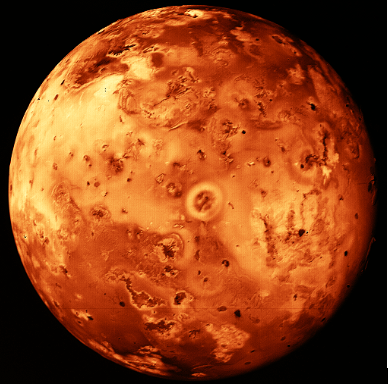NASA’s Juno solves Decades-old mysteries about Io
- Carla Ortiz
- Jan 14
- 2 min read

(image of Io) (NASA, 2024)
NASA’s Juno spacecraft has found groundbreaking data during its close flybys of Jupiter’s volcanic moon Io, providing answers to questions raised since Voyager 1’s 1979 observations. Despite being similar in size to earth’s moon, Io is the most volcanically active body in the solar system, having about 400 volcanoes that constantly release lava and plumes across its surface (CNN, 2024).
Recent flybys by Juno in December 2023 and February 2024, within 1,500 kilometers of Io’s surface, allowing scientists to closely study the moon, including its poles, for the first time. Contrary to earlier hypotheses that suggested the moon might be underlain by an “ocean” of magma, Juno’s finding show that Io’s volcanoes are fueled by individual magma chambers located beneath each eruption site. Since its discovery by Galileo Galilei in 1610, Io has intrigued astronomers, but its extreme volcanic activity wasn’t uncovered until the Voyager 1 mission. The moon’s surface, described as resembling a “pepperoni pizza”, was revealed to create constant eruptions. Scientists theorized that tidal forces exerted by Jupiter’s immense gravitational pull melted into Io’s interior, generating enough heat to create a subsurface magma ocean.
Juno’s high-precision Doppler data, along with previous mission findings and ground-based observations, suggested other saw. The gravitational forces form Jupiter create “tidal flexing,” squeezing Io and generating internal heat. This constant deformation melts parts of IO interior but not to the extent of forming a global magma ocean. Instead, each volcano appears to be powered by its own localized magma reservoir, answering the mystery lingering since voyager 1’s discoveries. This discovers makes scientists reconsider how tidal forces affect planetary interiors, which could potentially impact theories about habitability and evolution in distant worlds (park, 2024).
Juno’s mission remains active, with additional flybys planner for January 2024. Having travelled over a billion kilometers since its arrival at Jupiter in 2016, the spacecreaft cotinues to reveal new details about the gas giant and its moons.
Works cited:
“Jupiter’s Moon, Io.” Nasa.gov, 2024, starchild.gsfc.nasa.gov/docs/StarChild/solar_system_level2/io.html. Accessed 16 Dec. 2024.
“Io - NASA Science.” Nasa.gov, 17 Nov. 2017, science.nasa.gov/jupiter/moons/io/. Accessed 16 Dec. 2024.
Carter, Jamie. “Jupiter’s Moon Io Doesn’t Have an Ocean of Lava, Scientists Say.” Forbes, 15 Dec. 2024, www.forbes.com/sites/jamiecartereurope/2024/12/15/jupiters-moon-io-doesnt-have-an-ocean-of-lava-scientists-say/.
Strickland, Ashley. “New Observations of the Most Volcanic World in Our Solar System Solve a Mystery That Began with Voyager 1.” CNN, 14 Dec. 2024, edition.cnn.com/2024/12/13/science/jupiter-moon-io-lava-chambers/index.html. Accessed 16 Dec. 2024.
iain.todd@ourmedia.co.uk. “‘Mouldy Pizza’ Moon Is Most Volcanic Place in the Solar System. NASA Has Just Found out What’s Going on inside It.” BBC Sky at Night Magazine, 14 Dec. 2024, www.skyatnightmagazine.com/news/nasa-juno-reveals-interior-jupiter-moon-io. Accessed 16 Dec. 2024.
“Io, Jupiter’s Chaotic Volcano Moon.” The Planetary Society, 2016, www.planetary.org/worlds/io. Accessed 16 Dec. 2024.






Kommentarer